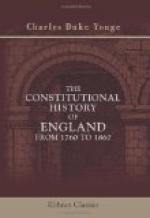[Footnote 152: “Lives of the Chancellors,” c. clxxxiv., life of Lord Erskine.]
[Footnote 153: “Lives of the Chancellors,” c. clix., life of Lord Thurlow.]
[Footnote 154: See “Memoires de M. de Metternich,” ii., 156.]
[Footnote 155: “Lives of the Chief-justices,” iii., 175.]
[Footnote 156: Lord Stanhope, “History of England,” i., 133.]
[Footnote 157: “Lives of the Chief-justices,” ii., 451. He is quoting H. Walpole.]
[Footnote 158: Ibid., iii., 187.]
[Footnote 159: Campbell’s “Lives of the Chief-justices,” II., 139, life of Chief-justice Holt; and p. 418, life of Lord Mansfield.]
[Footnote 160: “Life of Wilberforce,” i., 158.]
[Footnote 161: The division in the Lords was 100 to 36; in the Commons, 283 to 16.]
[Footnote 162: Afterward the Earl Grey of 1831.]
[Footnote 163: See especially his “Letters to Lord Castlereagh,” p. 814; and “Life of Lord Liverpool,” i., 512; ii., 35, 49, 127.]
[Footnote 164: Lord Colchester’s “Diary,” ii., 49, dated April 3, 1806, says eighteen years. But Mr. Windham’s speech, as reported in the “Parliamentary History,” second series, vi., 685, says sixteen years; and as he divides the ages into three classes, the two latter of which, from twenty-four to thirty-two, and from thirty-two to forty, are of eight years each, it is probable that the younger class was of the same duration, i.e., from sixteen to twenty-four.]
[Footnote 165: Lord Colchester’s “Diary,” ii., 300.]
[Footnote 166: See “Diary of Lord Colchester” (Speaker at the time), c. xxxvi., p. 316. He gives the whole of the Prince’s letter to Perceval (which had been composed by Sheridan), and of Perceval’s reply. The Regency Bill became law February 5, 1811.]
[Footnote 167: A letter of Lord Wellesley to Lord Grey, June 4 (given by Pearce, “Life of Lord Wellesley,” iii., 270), shows that Lord Moira had been in communication with Lord Grey and Lord Grenville before Lord Wellesley had given up the idea of forming a ministry. And though Lord Grey in his reply (p. 272) expresses his conviction that Lord Moira’s letter was not “an authorized communication,” but only “a private communication,” it is clear that it could not have been written without the privity of the Regent.]
[Footnote 168: “Life of Sheridan,” ii., 425.]
[Footnote 169: Pearce’s “Life of Lord Wellesley,” iii., 276. All the letters which passed between Lord Grey, Lord Grenville, Lord Moira, and Lord Wellesley himself are given at full length by Mr. Pearce in that chapter.]
[Footnote 170: Stapleton’s “George Canning and his Times,” p. 202.]
[Footnote 171: Mr. Stapleton affirms that his Royal Highness actually did adopt this plan on this occasion: “His Royal Highness adopted the unprecedented course of commanding his servants to elect the First-minister. Their choice fell on Lord Liverpool.”—George Canning and his Times, p. 208. Mr. Stapleton, however, gives no authority for this assertion, and he was probably mistaken, since Lord Liverpool’s papers afford no corroboration of it, but rather tend to disprove it.]




